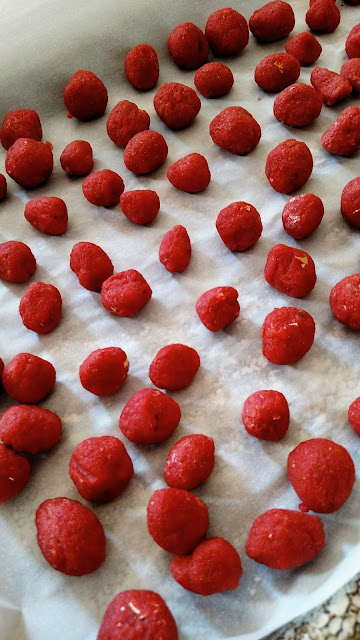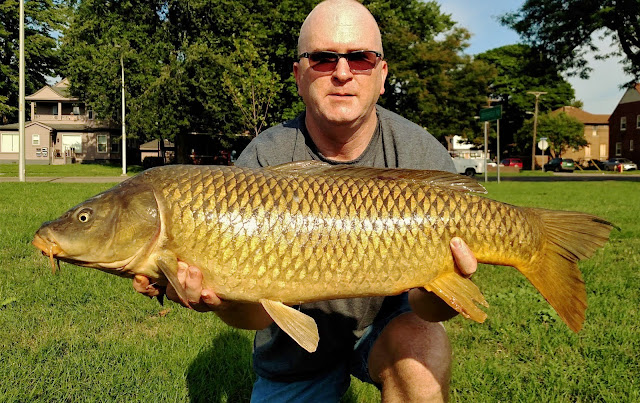The river is very challenging - to the point that every catch from the river is worth 4 or 5 from the local lakes I fish.
The river is less of a river than a strait. The French named the city Detroit after the French word meaning water connecting two large bodies of water, a "strait". According to
Michigan.org:
"le detroit du Lac Erie," meaning "the strait of Lake Erie." On July 24, 1701, a French explorer and nobleman by the name of Antoine de la Mothe, sieur de Cadillac founded Detroit.
The Detroit River connects Lake St. Clair to Lake Erie. There is a current, which in my experience varies from location to location and varies based on the time of day.
Strategy and Technique
In the morning before dawn the current is very light. I've seen the river waters very smooth, calm and ripple free at dawn. It's a great time to fish the river. As the sun rises, the carp begin to feed more actively on the surface, can easily be seen and "targeted" with strategic casts.
The west side of Grosse Ile, west side of Mud Island and west side of Belle Isle all have less large boat traffic than do the east sides of those locations.
As boat traffic increases during the day, the current in the river also increases. The boats churn up more weeds and debris, creating challenges holding the hook bait in place on bottom. When significant quantities of weeds build up on the line, it creates more and more drag by the river current requiring heavier lead; or retrieval and recasting.
For leads, I have used 2 oz to 5 oz sizes in the Detroit River. There are places that require very heavy sizes, but in the heaviest current the chances of holding bottom completely are pretty slim. I prefer to find a structure and fish behind it as a current break, or to let the pack bait rest directly against the seawall.
I suggest using the lightest lead size you are comfortable with. The heavier leads will definitely hang up on snags more easily and more often.
Fishing the Detroit River requires more frequent casting and re-baiting. I recommend you take extra ingredients for making packbait. I have noticed that more frequent re-casts seem to result in more fish. In a lake the bait just sits there, but on a river it disperses more quickly. I like to use more corn in my pack bait when fishing the river. Also, don't make the pack extra big on the river. Bigger pack bait is going to make it more buoyant and make it more difficult to hold in one place.
I use panko bread crumbs, bird seed, chicken feed, cooked field corn and peanut suet for a pack bait mix. You can flavor the cream corn or not; its up to you.
Consistent casting and baiting will help you catch more fish in areas with less current.
After you have identified a likely location that holds fish, recasting to the same spot does three things:
- Holds fish already there in the location for a longer period
- Draws more fish into the spot
- Increases the odds you may catch one or more fish
You can't catch what's not in front of you. So its a smart strategy to hold what's there and bring more in.
My carp rig of choice is a bolt rig with #4 or #6 Gamakatzu G-Carp hook, a 4 1/2" hook length, and hair rig with 3 pieces of flavored corn on a 3/4" hair.
During a recent trip to Elizabeth Park in Trenton, 100+ boats launched from a nearby marina for a bass tournament. The water disruptions were really not that bad. The river is so big that any wake is distributed enough in that location that it's usually minimal by the time it reaches the shoreline.
It may be too late in the fishing season this year, but I plan to begin a serious project to begin documenting a greater concentration on catching carp in the Detroit River next year.
There are many locations and people I meet that would make intriguing subjects for future articles here on the blog.
The photo possibilities are pretty cool too.
- Can you imagine catching a carp photo selfie with the Renaissance Center or Ambassador Bridge in the background?
- How about a large ocean going tanker?
- Border Patrol boats?
- Coast Guard vessels?
- Lighthouses?
I think it would be epic.
From Grosse Point to the Lake Erie Metro Park, there are 25 to 30 viable public fishing locations to access the river (and possibly even a few more). Some spots are better than others. One of the most attractive locations has a time limit for shore fishing (you can't start before 6 a.m. and you must finish by 10 a.m.). Another great venue in Wyandotte, BASF Park, unfortunately doesn't allow shore fishing at all.
There are a few piers that sometimes become crowded with other fishermen, depending on the season and weather patterns. A few locations are in pretty heavy current (near Mud Island).
 |
| If you look around, there are several public locations with current breaks that enable fishing in calm water. |
 |
| This location has a reputation for having a lot of snags in the water, but I've learned that snags are reduced by using lighter leads and keeping the rod tip elevated perpendicular to the water when retrieving line for re-baiting. |
 |
| Imagine a carp photo with Caesar's Windsor in the background |
 |
| This location doesn't produce a lot of fish, but it's accessible for river fishing, although space is limited. And even more so in 2020 due to floating debris, a fallen tree and significant bank erosion. |
 |
| A view from a swim on Belle Isle that I fished a couple of times this year. |
I plan to also incorporate more videos going forward as well.
It will be a good way to look forward to 2021 and put 2020 in the rear view mirror.
Places to Fish in Detroit
The list below will include venues in Detroit and throughout the greater Metropolitan area, from Trenton in the south to Grosse Point to the north.
Trenton
Rotary Park
 |
| This spot has some snags to overcome, but is a good option to access the river. I have only managed one catfish from this location in 2 hours I've spent fishing there. |
Elizabeth Park
 |
| There is a lot of bank space in this location, but there is also a lot of pedestrian activities including walkers, runners, dogs, bicycles, etc. |
Meyer Elias Park
 |
| There isn't a lot of bank space in this location. Bank erosian has reduced the fishable spots tremendously in the past 6 to 8 years. It becomes very weedy too. |
Detroit River International Wildlife Refuge
I really had high hopes for carp fishing at the refuge pier just south of Trenton. Unfortunately, my anticipation ended in disappointment.
Straight down from the pier railing where I fished, the depth is 5'. Unfortunately, that's probably not ideal for river carp fishing. I've had better results in finding deeper drop offs up to 12 - 15 feet and also spots that are 10 feet or so across the board.


















































